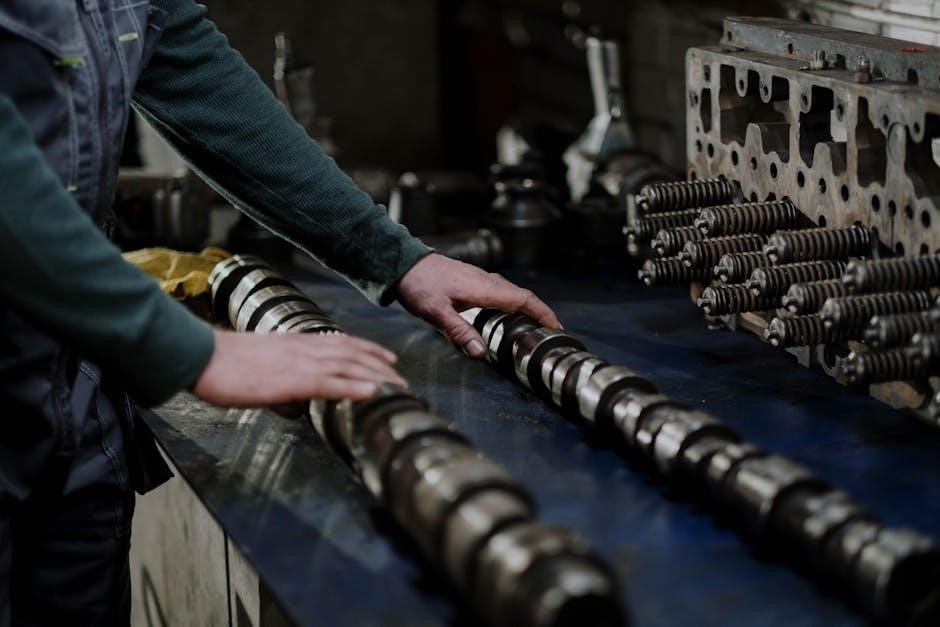A flat rate guide is a system providing standardized times for specific repairs, enabling accurate labor cost estimation and streamlined pricing processes in small engine repair․
1․1 What is a Flat Rate Guide?
A flat rate guide is a standardized manual or system that provides pre-determined labor times for specific repair tasks in small engine maintenance․ It outlines the expected time required for each job, allowing technicians to estimate costs accurately․ This guide ensures consistency in pricing and helps avoid undercharging or overcharging customers․ By referencing the flat rate guide, repair shops can streamline their billing process and maintain transparency․ It is widely used in the industry to standardize repair times and ensure efficient service delivery․ This system is essential for small engine repair businesses to operate effectively and maintain customer trust․
1․2 Importance in Small Engine Repair
The flat rate guide plays a crucial role in small engine repair by ensuring accurate labor cost estimation and consistent pricing․ It helps mechanics avoid undercharging or overcharging, fostering customer trust and satisfaction․ Additionally, it streamlines the repair process, reducing administrative burdens and allowing technicians to focus on their work․ By providing standardized times, the guide enhances efficiency and transparency, making it an indispensable tool for small engine repair shops to maintain profitability and deliver high-quality service consistently․ This system is vital for the smooth operation of repair businesses in the industry․

Understanding Flat Rate Pricing
Flat rate pricing is a system where customers are charged a predetermined amount for specific repair tasks, covering labor, parts, and service time, ensuring transparent cost estimation․
2․1 Labor Costs and Estimation
Labor costs are determined by standardized times for specific repair tasks, ensuring consistent pricing․ Flat rate guides provide detailed estimates, helping mechanics and shops charge accurately․ This system accounts for skill levels, time efficiency, and industry standards, reducing variability․ By referencing these guides, repair shops can efficiently calculate labor expenses, ensuring transparency for customers․ Accurate labor estimation also aids in pricing strategies, maintaining profitability while offering competitive rates․ This approach streamlines operations and enhances customer trust in repair costs․
2․2 Parts and Materials Pricing
Parts and materials pricing in flat rate guides ensures accurate cost estimation for repairs․ These guides list predefined prices for components, reflecting market rates and supplier costs․ Shops often reference OEM and aftermarket parts to set competitive yet profitable prices․ The flat rate system integrates parts costs with labor, providing a comprehensive estimate․ This approach ensures transparency, as customers see itemized pricing for components․ Regular updates to parts pricing in flat rate guides help shops adapt to market fluctuations, maintaining profitability while offering fair rates to customers․
2․3 Service Time Estimation
Service time estimation in flat rate guides provides standardized durations for specific repair tasks, ensuring consistency and accuracy․ These guides outline the expected time required for each job, allowing mechanics to efficiently plan and schedule repairs․ By referencing flat rate manuals, shops can avoid under or overestimating labor hours, improving workflow and customer satisfaction․ This system also helps in training new technicians by establishing clear benchmarks for repair times, ensuring uniformity across the industry and enhancing operational efficiency for small engine repair businesses․

Pricing Strategies for Small Engine Repair
Flat rate guides enable effective pricing strategies by standardizing labor costs and parts pricing, ensuring competitive rates while maintaining profit margins for small engine repair services․
3․1 Competitive Analysis
Flat rate guides facilitate competitive analysis by providing standardized pricing benchmarks for small engine repairs․ Businesses can compare their rates with industry standards, ensuring they remain competitive while maintaining profitability․ For instance, shops often adjust their hourly rates based on local competition, as seen in recommendations to charge $10 less than competitors․ Additionally, flat rate guides help identify market trends, such as regional pricing variations, allowing businesses to tailor their strategies to local demand․ This approach ensures fair pricing and customer satisfaction, fostering long-term business growth in the small engine repair market․
3․2 Customer Perception and Satisfaction
Flat rate guides enhance customer satisfaction by providing transparent and upfront pricing for small engine repairs․ Customers appreciate knowing the exact cost before work begins, reducing misunderstandings and building trust․ This clarity aligns expectations, ensuring customers feel confident in the value they receive․ Additionally, standardized pricing fosters a perception of fairness, which can lead to repeat business and positive reviews․ Transparent billing also demonstrates professionalism, reinforcing customer loyalty and satisfaction in the repair process․
3․3 Dynamic Pricing Based on Demand
Dynamic pricing adjusts repair costs based on demand fluctuations, ensuring competitiveness and profitability․ During peak seasons, such as summer for lawn mowers or winter for snow blowers, prices may increase due to higher demand․ Conversely, off-season discounts can attract customers․ This strategy balances supply and demand, optimizing revenue while maintaining customer interest․ Shops using flat rate guides can apply dynamic pricing by adjusting labor rates or offering promotions, ensuring they remain competitive and responsive to market needs․ This flexibility enhances profitability and customer satisfaction․

Benefits of a Flat Rate Guide
A flat rate guide ensures transparency in billing, builds customer trust, and streamlines repair processes, providing consistent and fair pricing for small engine repair services․
4․1 Transparency in Billing
Flat rate guides provide clear, predefined labor costs for specific repairs, ensuring transparency in billing․ Customers receive detailed estimates upfront, reducing uncertainties and building trust․ By outlining standard times for tasks, the guide eliminates billing disputes, as charges are based on established rates rather than variable labor hours․ This approach fosters accountability and fairness, making it easier for customers to understand and accept the final cost of small engine repairs․
- Clear, upfront pricing․
- Reduces billing disputes․
- Builds customer trust through transparency․
4․2 Increased Customer Trust
Flat rate guides foster trust by providing upfront, consistent pricing for repairs, eliminating hidden fees and unexpected charges; Customers appreciate knowing the exact cost before work begins, reducing anxiety and uncertainty․ This transparency creates a sense of fairness, as all customers are charged the same for identical tasks․ Over time, this consistent and predictable billing builds loyalty and strengthens relationships between repair shops and their clients, enhancing overall customer satisfaction and trust in the service provider․
- Upfront pricing reduces uncertainty․
- Consistent pricing ensures fairness․
- Transparency builds long-term loyalty․

4․3 Streamlined Repair Process
Flat rate guides streamline the repair process by providing standardized times for specific tasks, reducing delays and inefficiencies․ Mechanics can quickly reference the guide to determine the expected time for a repair, allowing them to prioritize tasks and manage their workload more effectively․ This consistency also ensures that repairs are completed in a timely manner, minimizing downtime for customers․ Additionally, the predefined pricing and timeframes help shops allocate resources more efficiently, leading to faster turnaround times and improved overall productivity․
- Standardized repair times reduce delays․
- Mechanic efficiency is improved․
- Resource allocation becomes more effective․

Market Trends in Small Engine Repair Pricing
Flat rate guides influence pricing trends by standardizing labor costs and repair times, ensuring consistency across the industry and reflecting regional and economic factors․
5․1 Industry Standards and Practices
Industry standards for small engine repair often incorporate flat rate guides to ensure consistency and fairness in pricing․ These guides, widely adopted by dealers and repair shops, provide predefined labor times for specific tasks, enabling accurate cost estimation․ Standardized pricing helps maintain customer trust and industry credibility․ Shops typically adhere to these guidelines to avoid overcharging and ensure transparency․ Regional variations may exist, but the core principle remains consistent: fair, predictable pricing based on established repair times and labor rates․
5․2 Impact of Technological Advancements
Technological advancements have significantly influenced small engine repair pricing, enhancing efficiency and accuracy․ Modern diagnostic tools enable quicker issue identification, reducing labor time and costs․ Digital flat rate guides provide real-time updates, adapting to new repair complexities․ Additionally, automated systems streamline parts ordering and inventory management, minimizing delays․ These innovations ensure that flat rate pricing remains competitive while maintaining high service standards, benefiting both repair shops and customers alike․
5․3 Regional Variations in Pricing
Regional variations in small engine repair pricing are influenced by local factors such as labor costs, competition, and market demand․ Urban areas often have higher rates due to increased operational expenses, while rural areas may offer lower pricing․ Seasonal demand also plays a role, with peak times for lawn mowers or snow blowers affecting prices․ Additionally, regional differences in parts availability and taxes can impact flat rate pricing, making it essential for repair shops to adapt their strategies to local conditions to remain competitive and customer-friendly․

Common Small Engine Repairs and Pricing
Common small engine repairs include lawn mower tune-ups, chain saw maintenance, and generator servicing․ Pricing varies based on labor time and parts, following flat rate guidelines․
6․1 Lawn Mower Repair Pricing
Lawn mower repairs are priced using flat rate guides, with common tasks like blade sharpening or oil changes costing between $15 to $50․ More complex repairs, such as deck cleaning or carburetor adjustments, range from $30 to $100․ Labor times are standardized, ensuring consistent pricing․ For example, a typical blade sharpening may take 0․5 hours, while a deck cleaning might take 1․5 hours․ Prices vary by location and shop rates, but flat rate guides help maintain transparency and efficiency in billing․
6․2 Chain Saw Maintenance Costs
Chain saw maintenance costs vary based on tasks, with common repairs like chain sharpening or air filter cleaning priced between $5 to $20․ More complex tasks, such as carburetor adjustments or chain replacements, range from $30 to $50․ Flat rate guides standardize labor times, ensuring consistent pricing․ For example, chain sharpening may take 15 minutes, while a carburetor adjustment could take up to 2 hours․ These guides help shops maintain transparency and efficiency in billing, ensuring customers understand the costs upfront․
6․3 Generator Repair Estimates
Generator repair estimates vary based on the type and extent of the issue․ Common repairs, such as replacing a faulty spark plug or cleaning a carburetor, typically range from $40 to $150․ More complex issues, like diagnosing and repairing a faulty ignition system, can cost between $100 and $300․ Flat rate guides provide standardized labor times, ensuring consistent pricing․ For example, a carburetor adjustment might take 1 hour, while a full ignition system overhaul could take 3-4 hours․ These estimates help shops provide transparent and reliable pricing for generator repairs․
6․4 Snow Blower Service Pricing
Snow blower service pricing varies based on the repair type and complexity․ Routine maintenance, such as inspections, oil changes, and spark plug replacements, typically costs between $50 and $150․ Common repairs, like carburetor cleaning or belt replacements, range from $75 to $200․ More extensive issues, such as auger repairs or engine overhauls, can cost $200 to $500 or more․ Flat rate guides provide standardized labor times, helping shops estimate costs accurately․ For example, a carburetor cleaning might take 1․5 hours, while an auger repair could take 3-4 hours․ Prices may vary by location and technician expertise․

Maintenance and Repair Tips
Regular small engine maintenance, such as oil changes and filter replacements, ensures optimal performance․ Seasonal storage tips and adhering to manufacturer guidelines help prevent damage and extend lifespan․
7․1 Routine Maintenance for Small Engines
Routine maintenance is crucial for extending the lifespan and performance of small engines․ Regular oil changes, air filter cleaning, and spark plug replacements are essential tasks․ Additionally, checking fuel lines and carburetors ensures proper fuel flow․ Proper maintenance also involves inspecting and sharpening cutting tools, like mower blades, to maintain efficiency․ Following a flat rate guide can help standardize these tasks, ensuring consistent and reliable service․ Regular upkeep not only prevents breakdowns but also enhances overall engine reliability and customer satisfaction․
7․2 Seasonal Preparation and Storage
Seasonal preparation and storage are vital for maintaining small engine performance․ Before storing, drain fuel, clean or replace air filters, and apply a rust-inhibiting oil to cylinders․ Storing in a dry, secure location prevents damage from moisture and pests․ For engines used in winter, like snow blowers, ensure proper winterization, including fuel stabilization and blade inspection․ A flat rate guide can help standardize these preparatory tasks, ensuring engines remain in optimal condition year-round and reducing downtime during peak usage seasons․

Cost Structure Analysis
Cost structure analysis in small engine repair involves breaking down labor, parts, and overhead expenses to determine pricing strategies and ensure profitability under flat rate systems․
8․1 Labor Costs Breakdown
Labor costs in small engine repair are calculated based on the time required for each task, as outlined in flat rate guides․ Mechanics are paid according to these standardized times, ensuring consistent pricing․ Shops often set hourly rates by researching local competition and considering the expertise of their technicians․ This approach helps maintain profitability while providing customers with clear, upfront estimates․ Labor costs also include wages, benefits, and ongoing training for mechanics to stay updated on small engine technologies and repair techniques․
8․2 Parts and Materials Expenses
Parts and materials expenses are determined by the cost of components needed for repairs, as specified in flat rate guides․ Prices are based on supplier rates, market demand, and the type of part, such as OEM or aftermarket․ Shops often apply a standard markup to cover overhead and profit margins․ For example, a spark plug might be marked up 20-30% above its wholesale cost․ These expenses are then incorporated into the final repair estimate, ensuring transparency and consistency for customers while maintaining shop profitability․
8․3 Overhead and Operational Costs
Overhead and operational costs include expenses such as rent, utilities, tools, insurance, and employee wages․ These costs are factored into flat rate pricing to ensure profitability․ Shops often allocate a portion of these expenses to each repair job, based on the time and resources required․ For example, a shop with high rental fees may adjust its flat rate pricing to cover these costs․ This ensures that the business remains sustainable while providing fair and transparent pricing to customers for small engine repair services․
International Perspectives on Flat Rate Pricing
Flat rate pricing varies globally, reflecting regional labor costs and market demands․ European countries often use standardized systems, while Asian markets may incorporate local labor rates․ North America blends competitive pricing with customer expectations, influenced by cultural and economic factors․
9․1 Global Pricing Trends
Global pricing trends in small engine repair reflect regional variations in labor costs, market demands, and economic conditions․ In Europe, flat rate systems are standardized, while Asian markets often adapt pricing to local labor rates and competition․ North America sees a blend of competitive pricing and customer expectations, influenced by cultural and economic factors․ These trends highlight the importance of adapting flat rate guides to local contexts while maintaining consistency in repair standards․ International perspectives emphasize flexibility and customization to meet diverse market needs effectively․
9․2 Cultural and Economic Factors
Cultural and economic factors significantly influence flat rate pricing in small engine repair․ In regions with higher labor costs, flat rates may be adjusted to reflect local economic conditions․ Cultural expectations, such as perceived value of service, also shape pricing strategies․ For instance, in areas where customers prioritize affordability, repair shops may adopt more competitive flat rates․ Economic stability and inflation further impact pricing structures, as businesses balance profitability with customer affordability․ These factors underscore the need for adaptability in flat rate guides to align with local market dynamics and cultural expectations․

Machining and Component Repair
Machining and component repair involve specialized tasks like cylinder resurfacing and crankshaft grinding, with flat rate guides providing standardized labor times for these precise small engine repairs․
10․1 Cylinder Repair and Pricing
Cylinder repair in small engines often involves resurfacing, reboring, or replacing damaged components․ Flat rate guides provide standardized labor times for these tasks, ensuring consistent pricing․ Factors like engine size, extent of damage, and required precision influence repair costs․ Shops typically charge labor based on flat rate estimates, plus parts like new pistons or sleeves․ Pricing varies from $100 to $500 or more, depending on complexity․ This approach streamlines billing and helps customers understand costs upfront, fostering transparency in small engine repair services․
10․2 Crankshaft Grinding Costs
Crankshaft grinding involves polishing or machining the crankshaft to restore its surface․ Flat rate guides standardize labor costs, ensuring predictable pricing․ Typical costs range from $100 to $300, depending on engine size and repair complexity․ Factors like bearing replacement or additional machining can increase the price․ Using a flat rate guide streamlines the repair process and ensures transparency in billing, enhancing customer trust in small engine repair services․
10․3 Piston Replacement Pricing
Piston replacement pricing in small engine repair typically ranges between $200 to $500, depending on the engine size and complexity․ Labor costs are standardized through flat rate guides, ensuring consistency․ Parts, including the piston, rings, and connecting rods, account for a significant portion of the cost․ Additional expenses may arise if cylinder re-boring or crankshaft repairs are needed․ Flat rate guides provide transparent pricing, helping customers understand the charges upfront and enhancing trust in the repair process․
A flat rate guide is an essential tool for standardizing pricing in small engine repair, ensuring transparency and efficiency․ By providing predetermined labor times and costs, it streamlines the repair process, enhances customer trust, and facilitates clearer communication; This system not only benefits repair shops by optimizing their operations but also offers customers predictable and fair pricing․ As the industry evolves, adopting a flat rate guide remains a cornerstone for maintaining competitiveness and customer satisfaction in small engine repair services․